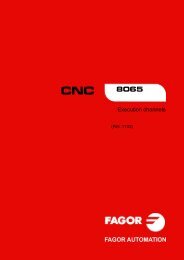4 - Fagor Automation
4 - Fagor Automation
4 - Fagor Automation
Create successful ePaper yourself
Turn your PDF publications into a flip-book with our unique Google optimized e-Paper software.
1.<br />
MILLING CANNED CYCLES.<br />
CNC 8065<br />
(REF: 1209)<br />
·62·<br />
G212. Outside thread milling cycle<br />
1.12 G212. Outside thread milling cycle<br />
Canned cycles (·M· model)<br />
This cycle may be used to make an outside thread through a helical movement of the tool.<br />
Working in Cartesian coordinates, the basic structure of the block is as follows:<br />
G212 Z D I J K B C L A E Q<br />
L<br />
K<br />
B<br />
Parameter definition:<br />
Z Reference plane.<br />
Defines the reference plane coordinate. It may be programmed either in absolute or<br />
incremental coordinates, in which case it will be referred to the starting plane.<br />
If not programmed, it assumes as reference plane the current position of the tool.<br />
D Safety distance.<br />
Defines the distance between the reference plane and the surface of the part where the milling<br />
is to be done. If not programmed, it assumes 0.<br />
I Machining depth.<br />
Defines the threading depth. It may be programmed either in absolute or incremental<br />
coordinates, in which case it will be referred to the reference plane.<br />
J Thread diameter.<br />
Defines the nominal diameter of the thread The sign indicates the machining direction of the<br />
thread (positive if clockwise and negative if counterclockwise).<br />
K Thread depth.<br />
It defines the distance between the crest and the root of the thread.<br />
J<br />
D<br />
B Thread pitch.<br />
Defines the thread pitch.<br />
With a positive sign, the direction of the thread pitch is from the surface of the part to the<br />
bottom.<br />
With a negative sign, the direction of the thread pitch is from the bottom to the surface of<br />
the part.<br />
C Type of tapping.<br />
Defines the type of tapping to be carried out. This parameter depends on the type of tool being<br />
used.<br />
When programming C= 0, the threading will be done in a single pass.<br />
When programming C=1, it will make one thread per each pass (single-edge cutter).<br />
When programming C=n (where n is the number of cutting edges of the cutter), it will make<br />
n threads per each pass.<br />
If not programmed, a value of C=1 is assumed.<br />
I<br />
Z<br />
G00<br />
G01<br />
G98<br />
G99<br />
M03<br />
M04

















